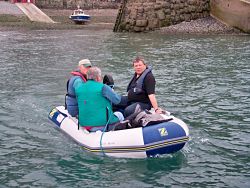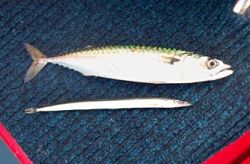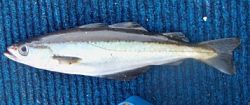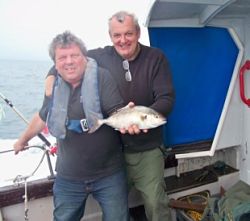One cloudy but still Tuesday, I collected Neil from The Royal Exchange in Torrington, and headed off to Clovelly for a day's sea fishing off Lundy Island. We arrived at the quayside to be met by Clive Pearson, skipper of the Jessica Hettie. Clive is the skipper who broke the porbeagle shark record in 1992 with a fish of 475lb. He is renowned as one of the best skippers in the area; he insists that the welfare of the fish caught is a priority and says that if one is going to eat their catch, the fish is despatched before unhooking, to minimise any suffering. If they're inedible, or too small, they're promptly unhooked and returned to the sea. This is a policy that I totally agree with.

We traversed from the rocky shoreline to the Jessica Hettie by inflatable dinghy as it was low tide at 8.30 am. Having boarded, we motored out to Lundy Island, a trip of just over an hour. There were six of us on the trip, Neil, Dave, Dave, Mick, Ray and myself.
Lundy has a 'no take' area on the eastern side so we stopped well short to start fishing for mackerel for bait and supper. I'd taken a lightweight travel spinning rod for this purpose. Whilst it won't handle 2lb lead one sometimes uses, it does handle a few ounces, so I cut the mackerel feathers down to three as recommended by Clive, and this, coupled with 8lb line, gave great sport on light tackle.

In fact, I had three mackerel on the first drop and caught regularly thereafter, aided I believe, by the lighter equipment being used in the clearer water off Lundy. I was also surprised to catch a large sand eel on the feathers, which was nearly as long as the average mackerel.
We then went around the south of the island, using strips of mackerel as bait for pollack, fished just off the bottom to avoid the dogfish. For this I changed to an uptide rod with multiplier and around 8ozs. of lead.

We all caught pollack of around 4 to 5 lbs. plus a few nice sized pouting from the first two marks, spending just under an hour in each. Clive also cooked some of the mackerel for lunch; it always tastes far better when freshly caught and it doesn't come any fresher than this.
Upon reaching the third mark off the west coast, away from the 'no take' zone, Clive suggested we fished with bait on some rods, and feathers on the others for the pollack, and to try a piece of bait on the bottom feather as there may be bream or trigger fish about. He then told us about a fish that he had taken the previous week which he couldn't identify, but was a bit like a bream. Shortly afterwards, Neil struck into a fish which gave a tremendous fight and when he got it on board, Clive said it was the same species that he had taken previously. Fortunately, from my recent experiences of fishing in Florida, I recognised it as a species of Jack. I couldn't remember one being caught in British waters before, but it seem likely that there was a small colony living in the waters off Lundy.
Trigger fish are now relatively common in the South West, and it would be great to see sportfish such as Jacks moving into the area. It would be a real boost to tourism, and the fishing community, both of which are experiencing difficult times.
We then moved to the north west of the island, where the swell seemed too big for a still day, and none of us could keep our feet. We tried spinning although this proved hazardous as one hand was definitely needed to hang onto the boat! Clive showed us how it should be done, as he caught a couple of wrasse, spinning with a weighted shad. None of the party were enjoying fishing there so we moved around the island to finish the day's fishing over a wreck. Sport here was very slow with the last couple of pollack being caught.

As we returned home, Clive filleted the fish for supper that evening, but although he'd gutted the Jack, I did manage to lay claim to it before it became fish fingers!
When I got home, I emailed photos to the Natural History Museum, and the National Marine Aquarium to identify the fish. There are no records of Jack being caught on rod and line in Britain, so I also contacted the Record Committee on behalf of Neil to register the fish. The paperwork is in the post now but I cannot complete it until we ascertained which species of Jack it is. The latest from the experts, via the National Marine Aquarium, is that the fish is a Greater Amberjack, confirmed by it only having 18 gill rakers. However, to claim a record this will have to be confirmed by the Natural History Museum in London.
Quite an extraordinary day's fishing, with great company and a good bag of fish for Sandy to cook for supper.